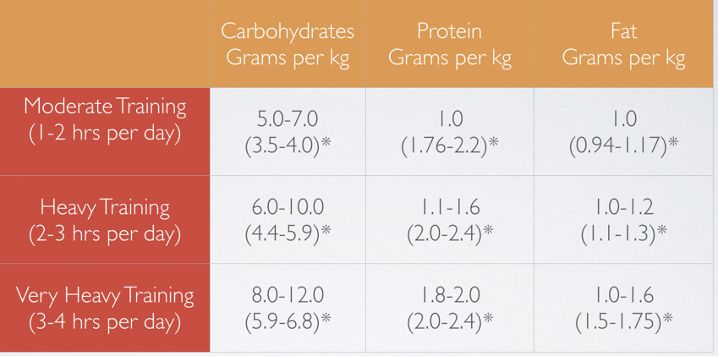How to fuel during a training block
Mad4Tri’s Nutrition and Hydration How-to series:
How to fuel during a training block.
Fueling. Every triathlete’s favourite thing. We train for umpteen hours each week, forego family time and miss out on that much-anticipated new Netflix series – we can at least eat what we want, right? Sadly, not quite. Whilst we do expend much more energy than the everyday adult, it is too often the case that many of us are not really aware of our own specific nutritional needs both while training and on race day. This series of blogs will cover everything from race day nutrition to hydration, female specific fueling to snacking,
Nutrition Periodization
Perhaps the most important consideration to begin with is this: how much training do you really do, and how much do you really need to eat for this training? Our fueling needs are dependent on the amount of energy we expend during the day, and for maximum efficiency needs to be broken in to macro-nutrients - carbohydrates, proteins and fats. Each macro has a specific job in terms of energy, muscle repair and stamina. In layman’s terms, carbs are the go-to energy source for the body for hi intensity training and racing. Protein repairs your muscles and tissues, and fat is a high density energy source for low intensity aerobic activities.
*Recommended for women (Sims)
An everyday athlete with a full-time job and a family, training for an Ironman distance race might aim to commit to between 7-14 hours of training per week, putting them in the ‘moderate training’ camp. According to Sports Nutrition for Endurance Athletes (2013), each day the ‘moderate training’ average athlete needs to take on between five and seven grams of carbohydrates per kilogram of body weight, and one gram of both protein and fat per kilogram. Women really need to pay special attention to their carb and protein intake, which differ to those of men. They also fluctuate depending on the phase of their menstrual cycle – fear not, we will go in to this in detail in another installment of the blog!
The more you train, the higher your requirements for all three macros, regardless of sex. The greatest increase when upping training load is in the carbohydrate intake, providing the athlete with the energy needed for this high energy expenditure. The fat intake doesn’t actually increase a huge amount for anyone however it is an important part of the mix as it is important for the function of our immune system and nerve cell function. Of the three macros, protein is the most essential for recovery and repair, and is a crucially important element of fueling. It’s also sometimes the hardest to keep at high levels – no one wants to eat six chicken breasts a day! Having said this, adding a scoop of protein to your breakfast yoghurt or pancakes can add 30g of protein to your daily macros – it’s that easy! At Mad4Tri, one of our favourite post-workout shakes is a scoop of chocolate protein, a banana, almond milk and a spoon of crunchy peanut butter. The banana adds in much needed carbs and potassium and the peanut butter incorporates some healthy fats, making this an ideal shake to begin your recovery as soon as you finish your session. In the height of the UAE summer, prepare your shake the night before and freeze it – leave it in a cool-bag in your car and it will be perfect by the time you finish a long session.
Another important consideration with regard to fueling is training load. For many triathletes, weekends tend to be heavier in terms of longer rides and runs. Your nutrition intake should reflect this. Your carbohydrate levels will need to increase as you refuel during the training itself, replenishing burned energy. These bigger training sessions need to be fueled in the preceding one or two days, not just with a bowl of porridge in the morning! You should also increase protein levels around heavier training loads to ensure maximum recovery… so that you can bounce back quicker the following week!
The below table shows the ideal calorie distribution for a 70kg athlete at all three training levels. Whilst it is tempting to just take in to account the overall total calories, the distribution of macros is essential… so no, we can’t just eat whatever we want!
It goes without saying that along with distributing our calories among the three macro groups, the quality of the fuel we provide our bodies with must also be a focus. A carb heavy diet does not mean loaves of processed white bread, bags of sweets and fizzy drinks are a go. Try instead for complex, nutrient rich carbohydrates like sweet potato, whole grain rice, beans and oats. Aim to get your proteins from lean meats, eggs, tofu, lentils and plain Greek yoghurt. Your fats should come from natural oil sources, avocados and nuts. A good go to rule – the fewer ingredients on the packet, the better! Of course, this isn’t to say that you can’t have any treats at all – at the end of the day, you work hard and deserve a reward. Just remember – while treats are a lovely mental boost, correct fueling will boost your energy, recovery and confidence.
Next – How to fuel: ladies special
References
Ryan, M. (2013) Sports Nutrition for Endurance Athletes, 3rd edition. VeloPress, Boulder
Sims, S, (2016) Roar. Rodale Books, Emmaus


